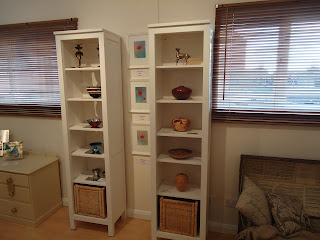This is a Sycamore blank that I roughed out a couple of months ago it was quite dry but I have speeded up the drying by using a microwave.
I use a jam chuck to hold the roughed out bowl and complete the underside.
This is the simple jam chuck made from a bit of scrap wood.
I keep a selection of these then there is always one that is about the right size.
The underside will be shaped and sanded to a finish
An important tip here is to take a little bit off the spigot to make sure that when you turn the piece it will be secure and balanced in the chuck.Also always make sure at this stage that you leave a centre mark you will see why later.
Here is a pick of what will be the eventual top of the bowl held securely in a jam chuck with some router mat for cushioning.
I always use a dust extractor and an air fed helmet when sanding.This simple set up is a bit of drain pipe and a stand.
Very easy to move around the shop and position where needed.
Here we have the bottom sanded to a finish and ready to turn.
With the bowl now reversed and held in the chuck we are ready to start carving.
I have flattened of the face but not sanded it at this stage as I will be removing the face later.
The carving is carried out using an Axminster power carver.This seems to get so hot that after a while I have to use a leather glove to hold it.
I asked Axminster if this was normal and they assured me that it was.
I have marked pencil lines just to give me a guide for my carving.
Here is a pic of the completed carving ready for the first colour.
The first colour I have applied is a very bright purple.It is important that the first colour is is darker than the top colour and quite bold.
As you can see I have made sure that the carved area is completely covered.
The paint is a good quality car paint in an aerosol.
To speed up the drying time I have used a hot air gun. Then I have sanded the paint off and finished the face down to 240 grit.I think that is smooth enough and leaves a key for the paint.
Having sanded the paint off the face it is now ready for the final colour.I have chosen Orange because I wanted a nice bright colour and it will go over the purple without spoiling it.
I have created a V groove either side of the carving with a V tool.This makes the coloured area stand out.
After a final cut on the inside of the bowl with a sharp bowl gouge I used a scraper to get a sandable finish.
I have power sanded the bowl down to 240 grit as i think this is fine enough when you are going to apply a lacquer
As I said before I use my air fed helmet when sanding I think this is very important.
I have applied one coat of Woodoc 20 with a good quality brush but I will apply several more coats later.
Woodoc products can be obtained from Phil Irons woodturning http://www.philirons.com/
This is after one coat and dried with a hot air gun not bad for one coat.
We have nearly finished just a bit of tidying up to do.
This is a simple idea for holding a bowl to finish the spigot and turn it into a foot.It is an idea I pinched from Mark sanger a round of plywood with a faceplate on the back and router mat on the front.
The bowl is trapped between the the ply faceplate and the tailstock to enable you to tidy up the foot.
The bowl is then remover and final tidying up done with a sanding disk in a Jacobs chuck.
A final buffing and a coat of Renaissance wax on the bottom and we are done.The bottom will not be lacquered as I like to keep it as polished wood. Thank you for looking I hope you found it interesting.
I will be putting up more info on texturing and colouring shortly so keep watching.

















































